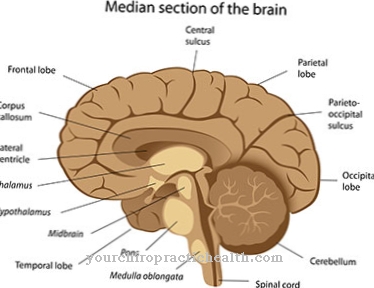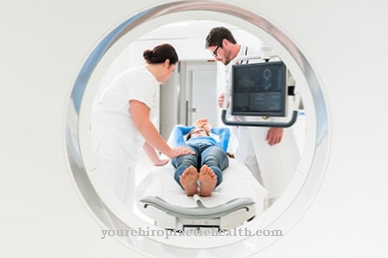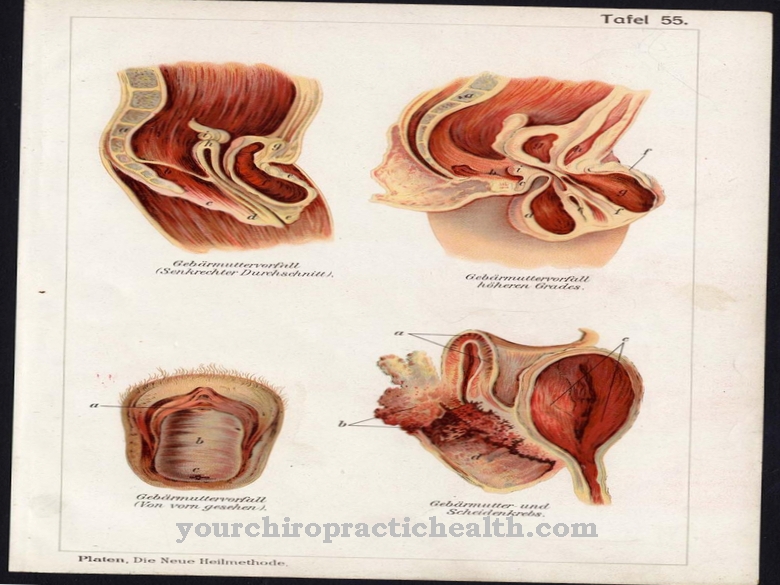In the congenital knee dislocationthe patient's lower leg is twisted and their knee joint surfaces are in insufficient contact. Non-invasive stretching is now available as a therapeutic measure. Only in extreme cases does the joint have to be surgically repositioned.
What is a congenital knee dislocation?

© designua - stock.adobe.com
Medicine speaks of a dislocation in the case of complete or incomplete loss of contact between two joint surfaces. A congenital knee dislocation is therefore a congenital joint misalignment in the knee. So this phenomenon affects the shin and thigh bones. The misalignment leads to an overstretching of the knee joint. The thigh muscles are shortened and the kneecap shifts outwards.
The cruciate ligaments are often missing or valgus and rotational malalignments occur. Chatelain first described this form of dislocation in the 19th century. Familial accumulation appears to have been observed in some families. In general, however, there is no question of actual heredity. A ratio of around 1.5 per 100,000 newborns is given as the prevalence for congenital knee dislocation. This makes knee dislocation a relatively common phenomenon.
causes
Congenital knee dislocation tends to occur sporadically. The exact causes of the misalignment have not yet been conclusively researched. Medicine assumes that overstretched legs in the womb may play a causal role. Fibrosis is also a possible cause. This applies in particular to fibrosis of the quadriceps femoris muscle (four-headed thigh muscle).
Since those affected by congenital knee dislocation often lack the cruciate ligaments, attention is also paid to this phenomenon. Nevertheless, muscle fibrosis due to overstretched positions in the womb is the more likely cause. In contrast to the missing cruciate ligaments, fibrosis is present in all patients with congenital knee dislocation. The congenital deformity can also occur in the context of various syndromes. For example, patients with Larsen and Down syndrome are more often affected by the deformity. In these cases, the phenomenon can also have a hereditary component.
You can find your medication here
➔ Medicines for joint painSymptoms, ailments & signs
The main symptom of a congenital knee dislocation can be seen with the naked eye. The patient's lower leg is twisted due to the misalignment and the thigh muscle is more or less shortened. The twisting of the lower leg is a dislocation out of the knee joint in which the lower leg is shifted forward.
The misalignment usually occurs on one side, but double-sided variants have also been observed. The double-sided form appears to occur primarily in the context of syndromes. If the congenital knee dislocation actually occurs as part of a syndrome, the phenomenon is accompanied by various symptoms. The accompanying symptoms then depend on the nature of the original disease.
In Larsen's syndrome, for example, multiple dislocations occur. There are also dysplasias of the skeleton. In syndromes like Zellweger's syndrome, not only skeletal and joint abnormalities occur, but also abnormalities of the brain and internal organs.
Diagnosis & course
Congenital knee dislocation can be seen immediately after birth by visual diagnosis. The typical twisting of the lower leg is sufficient for a reliable diagnosis. A sonography is often performed, which provides information about the exact position of the kneecap. X-rays can also show bony changes that are just as typical of knee dislocation as the twisted position of the lower leg.
In order to rule out the presence of a syndrome, in addition to the ultrasound and X-ray examinations, various exclusion procedures and tests are usually carried out. The course of a knee dislocation strongly depends on the time of the therapeutic intervention. Therefore, doctors usually recommend surgery as soon as the diagnosis is made. The earlier the dislocation is corrected, the less movement restrictions remain in the patient's further life.
Usually, the dislocation results in at least a somewhat limited ability to bend the lower leg, but this does not prevent the affected person from moving. If there is damage to the capsular apparatus in addition to the dislocation, doctors usually speak of a slightly less favorable prognosis.
Complications
Congenital knee dislocation is a painful knee misalignment that can lead to acute consequential damage. Usually the kneecap sits immovable and in place by ligaments. In the case of knee dislocation, however, the knee jumps out of the specified sliding path towards the outside of the knee. Most of the time it will slide back into the correct position on its own.
If those affected ignore the symptom, the complications will increase after each slip. The joint swells and chronic osteoarthritis can develop. In addition, the pain can become so severe that it becomes impossible to walk and stand without problems. The leg literally bends away at the knee joint. The symptom occurs around the age of 20.
Women are more likely to be affected than men. Due to the dislocation of the kneecap, the ligaments, the fine tissue as well as cartilage and bones are overstrained. If the symptom is not treated early on, ligaments and cartilage can tear and severe damage to the holding apparatus as well as pain that extends to the thigh bone occurs. The medical diagnosis is made using X-rays or MRI.
Any bone and ligament damage that has arisen is surgically corrected. A subsequent physiotherapeutic measure helps the person affected to be able to load his knee joint again. A special bandage must be worn depending on the severity of the findings. Those affected with congenital knee dislocation should therefore exercise the thigh muscles regularly to reduce the risk of complications.
When should you go to the doctor?
Congenital knee dislocation is usually diagnosed immediately after birth. The responsible doctor will inform the parents about the misalignment and refer them to a pediatric orthopedic center for further treatment. In most cases it is possible to correct the knee dislocation with orthopedic measures. Whether another operation is necessary afterwards depends, among other things, on the severity and location of the deformity.
Further medical measures are necessary, for example, if a redress cast, i.e. manual correction, does not achieve a satisfactory result. The exact procedure differs from case to case. Parents should therefore regularly consult the responsible doctor and consider all medical options. If the affected knee malfunctions in later life, a doctor must be consulted immediately.
The person affected sometimes needs therapeutic support, as the gait disorders that sometimes occur can lead to social exclusion and, as a result, to psychological problems. Normally, however, no long-term consequences are to be expected from prompt treatment.
Doctors & therapists in your area
Treatment & Therapy
According to the current state of medicine, malpositions can be treated relatively effectively. For patients with congenital knee dislocation, treatment is carried out in a pediatric orthopedic center. The goal of therapy is to reposition the twisted joint, restoring the patient's mobility as much as possible. Often no surgery is required.
Under certain circumstances, stretching can already have the desired effect. The patient is usually placed under anesthesia to stretch the shortened thigh muscle. This anesthesia is particularly important given the patients' tender age. The position of the twisted joint can be influenced using a redression cast. As a rule, there are regular sonographic follow-up controls during which the previous successes of the joint repositioning are recorded.
If a redressive cast does not produce satisfactory results, surgical measures are often considered. In this regard, for example, surgical lengthening of the quadriceps is an option. The exact procedure for surgical muscle lengthening depends on the individual case. Several methods are possible. The extent of the misalignment, but also the quality of the capsular apparatus, can play a role in the selection of the surgical procedure, for example.
Outlook & forecast
In most cases this complaint results in relatively severe restrictions on the movement of the patent. The lower leg of the person concerned is usually very twisted, which also results in a shortening of the thigh muscle. This leads to a severe misalignment, so that normal everyday activities are made significantly more difficult by this disease.
It is not uncommon for those affected to suffer from depression or other mental disorders due to the restrictions. It has often happened that mostly children are affected by teasing because of the misalignment. This disease can also lead to significant limitations and delays in school sports or in child development.
The disease is treated with the help of various therapies or surgical intervention. In this way, most complaints can be limited so that there are no significant restrictions in the patient's everyday life. The life expectancy of the person affected is also not reduced by this disease.
The discomfort does not heal by itself, so that without treatment, severe discomfort and restrictions can occur even in adulthood. As a rule, the quality of life of the person affected is greatly reduced.
You can find your medication here
➔ Medicines for joint painprevention
Congenital knee dislocation cannot be prevented. Since the treatment options are now well advanced, there are hardly any impairments that greatly reduce the quality of life of those affected.
Aftercare
The knee dislocation is congenital. It can be remedied through therapy or an operation to such an extent that there are hardly any restrictions in everyday life. The recurrence of knee dislocation with significant effects is therefore excluded. Follow-up care must therefore pursue other goals. It's about maintaining mobility in everyday life.
Complete healing is not always possible. Sometimes there is a limited ability to bend. However, this does not have to lead to major restrictions in private life and work. Rather, it is important for patients to learn how to deal with the remaining deformity. Physiotherapists teach exercises.
Sick people can strengthen their thigh muscles, for example. A number of exercise bikes are suitable for this. In addition, patients should permanently maintain the mobility of their legs. Short walks should be integrated into everyday life. It is not uncommon for children to be affected by knee dislocation. You are regularly exposed to gossip in physical education classes.
This condition can cause a mental illness that is still present even after successful treatment. A doctor then regularly prescribes therapy to rebuild the decreased self-esteem. Doctors first diagnose a knee dislocation at birth. X-rays and ultrasound examinations are suitable for ongoing documentation of the disease.
You can do that yourself
The best thing in everyday life is to continuously do light sport. At home, it's a good idea to train at a low level on an exercise bike two to three times a week. This strengthens the thigh muscle, which is responsible for guiding the kneecap. The training also helps to develop a feeling for the correct sequence of movements for the flexor and extensor. Walks in the forest and doing small shopping on foot help maintain leg mobility and can be easily integrated into everyday life.
When cleaning or making beds, it is helpful to buy a knee mat and put it under it. This relieves the stress on the joint and no outside help is required for these activities. To make all movement sequences easier, it makes sense to use your hands as an aid. When sitting or standing up, it is advisable to shift your weight onto them and to be able to sit or stand by pressing or cushioning.
If you experience pain in everyday life, it is advisable to stop and manually test the patella guidance and correct it if necessary. Afterwards, it is usually possible to continue running without problems. For problems at night, it is advisable to smear quark on the knee and put on a loose bandage. The most comfortable and least painful sleeping position is on the stomach.


.jpg)
.jpg)




















.jpg)



